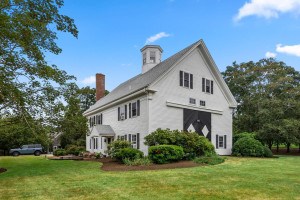What’s the Story Behind the Harvard Lampoon Building?
Welcome to “One Last Question,” where research editor Matthew Reed Baker tackles your most Bostonian conundrums. Have a question? Email him at onelastquestion@bostonmagazine.com.

Photograph by Jenny Villone
Question:
I was having a beer at the Cellar, near Harvard Square, the other night, and my drinking buddy started in on a story about how the Harvard Lampoon building—the funky one that looks like it has a jack-o’-lantern face—was designed by an architect who had an ax to grind with the school. Is that true?
—John Pollock, Belmont
Answer:
First, I’m delighted to join your ale-soaked pub chat about architecture, but unfortunately, I have to pour us all a pint of pedantry: Historians haven’t compared the humor magazine’s 1910 home to a pumpkin head, but rather to a jester or a surprised Prussian soldier. Since the rapidly rising nation of Germany was unified only 39 years previous, this kind of brick-and-mortar joke was probably funnier then.
After poking through architectural history books, I found that in fact it was not the building that was involved in a Crimson feud, but rather the land. Back in the 1890s, an alum named Charles Wetmore built Claverly Hall on Linden Street, only to learn that even-bigger Randolph Hall would be built just across the road, thus putting his dormitory in the shade. So naturally, Wetmore bought property a block away and threatened to eclipse everyone. In response, the developers of Randolph Hall set their dorm back 10 feet from the street to let sunlight in. So, there’s your ax.
As for who did build the Lampoon HQ there, look no further than legendary architect Edmund Wheelwright, who designed such landmarks as Longfellow Bridge and Horticultural Hall, where I sit writing you from Boston’s offices. Long before that, as an undergrad in 1876, he cofounded the Harvard Lampoon. Thus, when the editors and trustees purchased Wetmore’s land, Wheelwright treated his commission as a labor of love, even cladding the building’s Great Hall in some 7,000 Delft tiles, considered the largest display outside the Netherlands.
When Wheelwright’s baby opened, the Cambridge Tribune heralded it as “the finest quarters of the kind in the country,” while Cambridge Mayor Alfred Vellucci called it “one of the ugliest buildings in the world.” One hopes that if the architect were alive today, he’d take pride in the fact that talents such as John Updike and Conan O’Brien have toiled at wit within the castle’s Great Hall. Even more, I hope he’d be amused that 100 years after his death, Complex Media ranked his creation fifth on its list of “The 10 Most Ridiculous Phallic Buildings,” because—ahem—those kinds of jokes never get old.
Have a question? Email us at onelastquestion@bostonmagazine.com.


